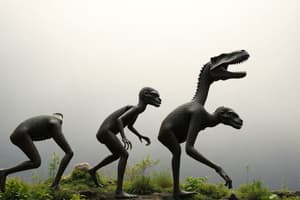Podcast
Questions and Answers
Which scientist developed the idea of natural selection independently of Darwin?
Which scientist developed the idea of natural selection independently of Darwin?
- Lamarck
- Wallace (correct)
- Darwin
- Galapagos
What is the term for a trait that is shared by different species because they both inherited it from a common ancestor?
What is the term for a trait that is shared by different species because they both inherited it from a common ancestor?
- Homologous trait (correct)
- Convergent trait
- Inherited trait
- Analogous trait
What is the term for a random change to a sequence of bases in an organism's DNA?
What is the term for a random change to a sequence of bases in an organism's DNA?
- Mutation (correct)
- Gene flow
- Natural selection
- Genetic drift
What is the term for a change in allele frequencies produced by random differences in survival and reproduction?
What is the term for a change in allele frequencies produced by random differences in survival and reproduction?
What is the term for the exchange of alleles between populations?
What is the term for the exchange of alleles between populations?
What is the term for the representation of the evolutionary history and relationships between groups of organisms?
What is the term for the representation of the evolutionary history and relationships between groups of organisms?
Which two domains of life are more closely related to each other?
Which two domains of life are more closely related to each other?
Which of the following is a distinguishing feature of Protists?
Which of the following is a distinguishing feature of Protists?
What is the function of leaves in plants?
What is the function of leaves in plants?
What innovation did Ferns have over Bryophytes?
What innovation did Ferns have over Bryophytes?
Which group of plants is the most abundant and diverse?
Which group of plants is the most abundant and diverse?
What is the general structure of fungi made up of?
What is the general structure of fungi made up of?
What is a distinguishing feature of Sponges?
What is a distinguishing feature of Sponges?
Which group of animals is characterized by their radial symmetry and presence of stinging cells?
Which group of animals is characterized by their radial symmetry and presence of stinging cells?
Which of the following best describes microevolution?
Which of the following best describes microevolution?
What is macroevolution?
What is macroevolution?
What are the conditions required for natural selection to occur?
What are the conditions required for natural selection to occur?
What happens at the individual level in natural selection?
What happens at the individual level in natural selection?
What happens at the population level in natural selection?
What happens at the population level in natural selection?
Which example from the lecture demonstrates natural selection?
Which example from the lecture demonstrates natural selection?
What is the primary mechanism of natural selection?
What is the primary mechanism of natural selection?
Which of the following characteristics distinguishes flatworms (Platyhelminthes) from other animal groups?
Which of the following characteristics distinguishes flatworms (Platyhelminthes) from other animal groups?
What is the distinguishing feature of annelids?
What is the distinguishing feature of annelids?
Which of the following characteristics is unique to echinoderms?
Which of the following characteristics is unique to echinoderms?
What is the distinguishing feature of chordates/vertebrates?
What is the distinguishing feature of chordates/vertebrates?
Which of the following is a characteristic of fish?
Which of the following is a characteristic of fish?
What is a distinguishing feature of birds (Aves)?
What is a distinguishing feature of birds (Aves)?
Which of the following characteristics is unique to mammals (Mammalia)?
Which of the following characteristics is unique to mammals (Mammalia)?
What is a primate known for?
What is a primate known for?
What is the distinguishing feature of hominins?
What is the distinguishing feature of hominins?
Polygenic Trees are used to organize the characteristics of different groups of organisms.
Polygenic Trees are used to organize the characteristics of different groups of organisms.
Bacteria and Archaea are genetically and biochemically distinct from each other.
Bacteria and Archaea are genetically and biochemically distinct from each other.
Protozoans are a subgroup of protists that are photosynthetic.
Protozoans are a subgroup of protists that are photosynthetic.
Leaves in plants perform photosynthesis to produce sugars and oxygen.
Leaves in plants perform photosynthesis to produce sugars and oxygen.
Ferns have the innovation of vascular tissues for efficient water and nutrient transport.
Ferns have the innovation of vascular tissues for efficient water and nutrient transport.
Gymnosperms are more abundant than angiosperms.
Gymnosperms are more abundant than angiosperms.
The structure of fungi is made up of hyphae and polycerids.
The structure of fungi is made up of hyphae and polycerids.
True or false: Microevolution refers to the evolution of large-scale structures and traits that go significantly beyond the intraspecific variation found in microevolution.
True or false: Microevolution refers to the evolution of large-scale structures and traits that go significantly beyond the intraspecific variation found in microevolution.
True or false: Macroevolution is a change in evolution that occurs over a short period of time.
True or false: Macroevolution is a change in evolution that occurs over a short period of time.
True or false: Natural selection is the process by which organisms that are more adapted to their environment are more likely to survive and pass on their genes.
True or false: Natural selection is the process by which organisms that are more adapted to their environment are more likely to survive and pass on their genes.
True or false: Genetic mutation plays no role in natural selection.
True or false: Genetic mutation plays no role in natural selection.
True or false: The struggle for existence, variation, and inheritance are the three conditions required for natural selection to occur.
True or false: The struggle for existence, variation, and inheritance are the three conditions required for natural selection to occur.
True or false: At the individual level, natural selection refers to the survival and reproduction of individuals that are best suited to their environment.
True or false: At the individual level, natural selection refers to the survival and reproduction of individuals that are best suited to their environment.
True or false: At the population level, natural selection results in the inheritance of favorable traits from one generation to the next.
True or false: At the population level, natural selection results in the inheritance of favorable traits from one generation to the next.
True or false: Annelids have a closed circulatory system?
True or false: Annelids have a closed circulatory system?
True or false: Nematodes have a pseudocoelom?
True or false: Nematodes have a pseudocoelom?
True or false: Echinoderms have bilateral symmetry?
True or false: Echinoderms have bilateral symmetry?
True or false: Fish have gills for respiration?
True or false: Fish have gills for respiration?
True or false: Reptiles have bony plates?
True or false: Reptiles have bony plates?
True or false: Birds lay soft-shelled eggs?
True or false: Birds lay soft-shelled eggs?
True or false: Mammals produce milk to feed their young?
True or false: Mammals produce milk to feed their young?
True or false: Primate is a subgroup of hominids?
True or false: Primate is a subgroup of hominids?
True or false: Fungi obtain nutrients through absorption?
True or false: Fungi obtain nutrients through absorption?
True or false: Lamarck's theory of "inheritance of acquired characteristics" was correct.
True or false: Lamarck's theory of "inheritance of acquired characteristics" was correct.
True or false: Homologous traits provide evidence for common ancestry.
True or false: Homologous traits provide evidence for common ancestry.
True or false: Analogous traits are traits shared by different species because they both evolved a similar adaptation.
True or false: Analogous traits are traits shared by different species because they both evolved a similar adaptation.
True or false: Mutation is a random change to a sequence of bases in an organism's DNA.
True or false: Mutation is a random change to a sequence of bases in an organism's DNA.
True or false: Genetic drift is a change in allele frequencies produced by non-random differences in survival and reproduction.
True or false: Genetic drift is a change in allele frequencies produced by non-random differences in survival and reproduction.
True or false: Gene flow is the exchange of alleles between populations.
True or false: Gene flow is the exchange of alleles between populations.
True or false: Speciation occurs when gene flow stops between two populations for a short period of time.
True or false: Speciation occurs when gene flow stops between two populations for a short period of time.
Flashcards are hidden until you start studying
Study Notes
Evolution and Characteristics of Different Organisms
- Microevolution refers to changes in the gene pool of a population, while macroevolution involves large-scale changes in evolution over many years.
- Natural selection is the process by which organisms that are better adapted to their environment are more likely to survive and pass on their genes.
- Examples of natural selection include the color change in peppered moths during the industrial revolution and the development of stronger beaks in finches to adapt to changing food sources.
- Darwin's contribution to advancing our knowledge of the natural world was developing the concept of natural selection, while Wallace independently developed the same idea.
- Lamarck's contribution was the incorrect theory of "inheritance of acquired characteristics."
- Homologous traits are shared by different species due to a common ancestor, providing evidence for evolution, such as the similarity in limb structure among tetrapods, humans, cats, whales, and bats.
- Analogous traits are similar adaptations that evolved independently in unrelated organisms, and they are due to convergent evolution.
- Mutation is a random change in an organism's DNA sequence, genetic drift is a change in allele frequencies due to random differences in survival and reproduction, and gene flow is the exchange of alleles between populations.
- Speciation occurs when gene flow stops between two populations for a sufficient period of time, leading to the formation of new populations.
- Phylogeny is the representation of the evolutionary history and relationships between groups of organisms, constructed using homologous traits, analogous traits, and molecular evidence.
- The three domains of life are Bacteria, Archaea, and Eukarya, with Bacteria and Archaea being more closely related.
- Major plant organs include roots for absorption and anchoring, stems for support and transport, and leaves for photosynthesis and gas exchange.
- Different groups of plants, such as bryophytes, ferns, gymnosperms, and angiosperms, have distinct characteristics and innovations, with angiosperms being the most abundant and diverse group.
Studying That Suits You
Use AI to generate personalized quizzes and flashcards to suit your learning preferences.




